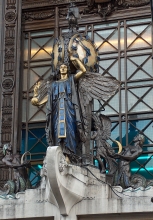 The Queen of Time, by Gilbert Bayes.
The Queen of Time, by Gilbert Bayes.
 The Queen of Time, by Gilbert Bayes.
The Queen of Time, by Gilbert Bayes.
The centre of gravity of Oxford Street, towards the western end, is Selfridges, and it bears a familiar and iconic sculptural group by the sculptor Gilbert Bayes, with at its centrepiece the Queen of Time. She stands, greatly larger than lifesize, an example of polychrome sculpture, her face and exposed arms and feet in a polished brassy colour, her hair and outer robes and spread wings in dark bronze, her dress and the hem of her robe in lustrous blue enamel. She is posed erect, staring straight forward, and slightly upwards into the visionary distance, her left hand raised and holding a sprig of foliage, her right holding a globe bearing a small angel, herself carrying a leafy branch and a wreath. Her enamelled dress falls symmetrically about her body, with more of a variation in the folds of her outer robe. She stands on the stone prow of ship, with waves indicated to either side, and behind and above her are the twin dials of the Selfridges Clock, for she is, after all, the Queen of Time. Upon the summit of the twin clocks is a small ship, a galleon of some sort with three masts and a single raised sail.
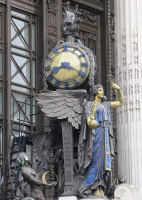
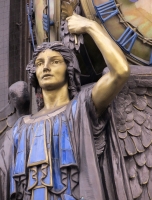
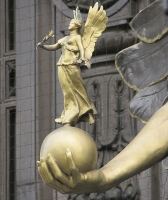 Another view, close up, and the Peace statuette.
Another view, close up, and the Peace statuette.
To left and right, above the waves, but reaching only to the mid-calf of the central figure, are a pair of mermaids, fantastical art nouveau creations in bronze with fins and scales enamelled in blue and green, and mosaic scales in red and brown further down each curled tail. They are of the variety of mermaid that has something of a skirt of little fins at the waist – see the mermaids page. More enamel and mosaic on the hairpieces of each figure, and each holds up a circlet in brass, thicker on the outside almost as if a crescent moon.
To the casual glance, it is easy to miss the other two figures in the composition – two winged youths, male and female, again flanking the central figure but to the rear and further in, slightly flattened. They are on considerably smaller scale, reaching only to knee height measured against the Queen. Each carries a small mallet and is seemingly concerned with the mechanism of the clocks. Behind and above this composition, against the wall two seminude girls act as a keystone to the whole ensemble of the portico, seated flanking some central tablet, their hands perhaps clasped together behind a heap of foliage and flowers, their faces turned away from each other.
One of rear figures, the upper group, and the figures flanking the door.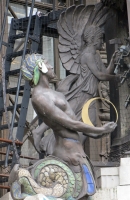
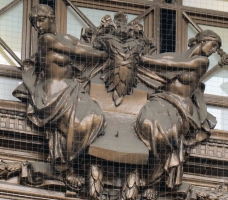


We are not finished with the bronze work yet, for down below, flanking the actual entrance doors, are a pair of standing female figures, still larger than lifesize, wearing decorous long robes hanging to the feet. The one holds a looking glass, the other contemplates a little group of sculpture in her hand, comprising a mother and child, nude, with behind some great carving of a grotesque bearded face. Two panels higher up show groups of cherubs with game, fat little things. And the metalwork abounds with little motifs, including shells and snarling lions’ heads on the upper rim of the doorframe. A palatial entrance fit for a Cathedral.
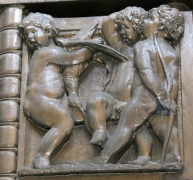
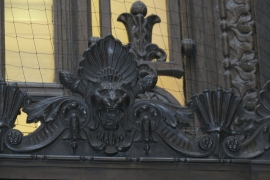
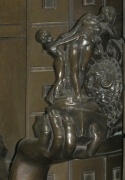 Minor bronze work: cherub panel, snarling lion head, small nudes.
Minor bronze work: cherub panel, snarling lion head, small nudes.
With the exception of the minor art metalwork, I believe all this to be by Gilbert Bayes. The minor Portland stone sculpture decorating the rest of the building, however, was carved by W. B. Fagan and W. Arrowsmith from models supplied by J. Else. Of these, W. B. Fagan at least is familiar, from his allegorical sculptures of America and Germany for the Hamberg-Amerika Linie Building in Cockspur Street (illustrated on this page). The principal stone sculpture comprises a number of oval frames, encircled by wreaths of flowers and ribbons, each with a sculpted head at the top. These heads, male and female, are richly modelled, and are ranged on the front and corners and around the sides of the building, at first floor level, and at the top above the pillars on the entablature. They are clearly echoed in the similar motifs incorporating winged cherubic heads at Oxford Circus.
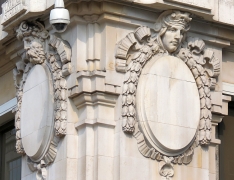
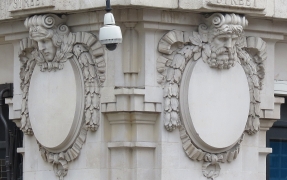
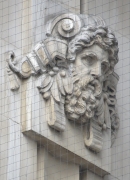
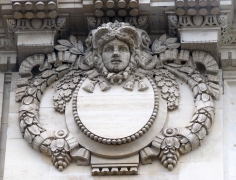 Selfridges stone sculpture, by W. B. Fagan.
Selfridges stone sculpture, by W. B. Fagan.
Among much minor sculptural details for the observant viewer to discover, we may note particularly the tops of the pillars, ionic with flowers, and little leaves hanging down the fluting.
London sculpture // Iconic London Sculpture // Sculptors
Visits to this page from 21 June 2013: 31,902